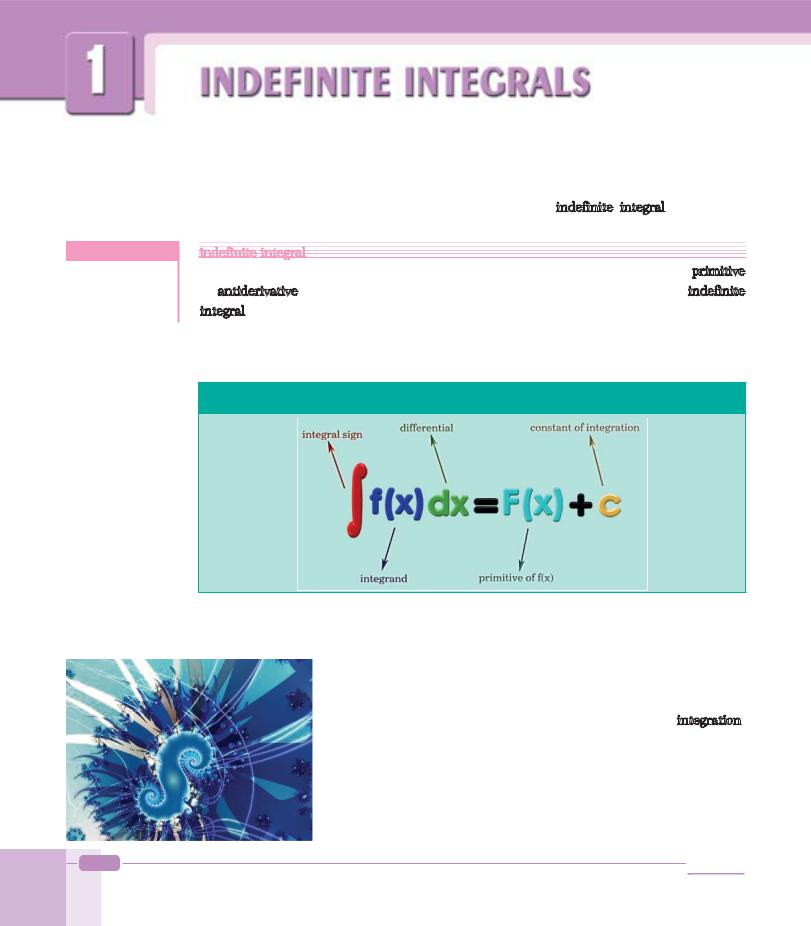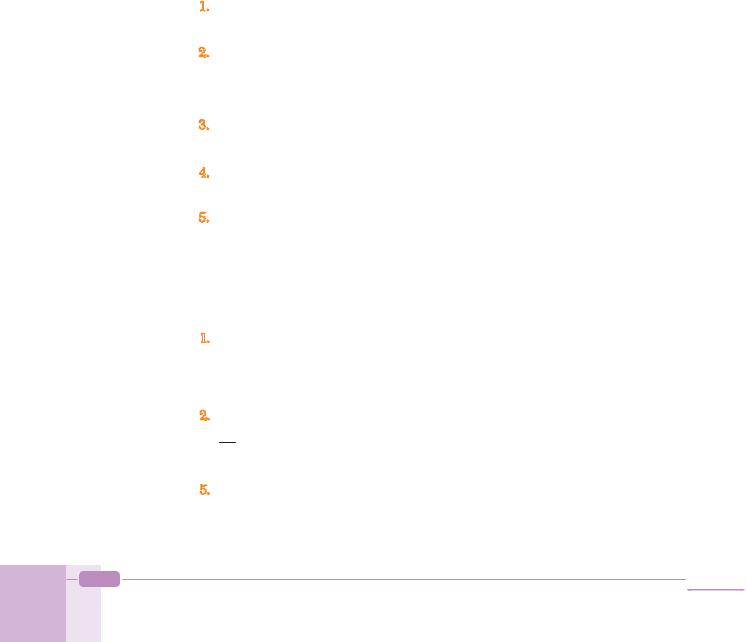
11 ALGEBRA
.pdf
CHAPTER 1 


A. ANTIDERIVATIVE AND INDEFINITE INTEGRAL
1. Definition of the Indefinite Integral
The set of all antiderivatives of a function is called the indefinite integral of the given function.
Definition |
indefinite integral |
|
Let F(x) be a differentiable function such that F (x) = f(x). Then F(x) is called the primitive |
|
or antiderivative of the function f(x), and the expression F(x) + c is called the indefinite |
|
integral of f(x). |
|
We write the indefinite integral as follows: f (x) dx = F(x)+ c. |
|
The different parts of the expression are as follows: |
|
THE INDEFINITE INTEGRAL |
The differential dx in the expression shows that we mean the indefinite integral with respect to the variable x. We can also find the indefinite integral with respect to other variables, for example:
f (t) dt = F(t)+c.
We read the expression f (x) dx as ‘the integral of f(x) with respect to x’. The process of finding the integral of a function is called integration.
To find the integral of f(x) we ask the question: ‘the derivative of which function is f(x)?’.
In other words, integration is the reverse operation of differentiation. This is why the integral is sometimes called the antiderivative of a function, plus a constant term. Let us look at some examples.
10 |
Algebra 11 |

EXAMPLE
EXAMPLE
1
2
2x dx = x2 + c |
|
|
(The derivative of x2 |
is 2x, so |
2x d(x)= x2 +c.) |
4x3 dx = x4 +c |
|
|
(The derivative of x4 |
is 4x3, so |
4x3 dx = x4 + c.) |
|
3 sin x dx = – cos x+ c |
|
EXAMPLE |
|
|
|
|
|
|
(The derivative of –cos x is sin x, so sin x dx = – cos x+ c. ) |
|
|
In examples 1 to 3 we add a constant c to each primitive. Why do we use it? To understand |
|
|
the reason, let us look at the derivatives of three different functions: |
|
|
y = x2, |
y = 2x; |
|
y = x2 + 3, |
y' = 2x; |
|
y = x2 – 6, |
y' = 2x. |
We can see that the derivatives of the three functions are the same but the primitive functions are different. In other words, the integral of 2x could be x2, or x2 + 3, or x2 – 6, or any other expression of the form x2 + c, where c is a constant number (i.e. not a variable). Similarly, the integral of 3x2 could be x3 + 7, or x3 – 12, or any expression of the form x3 + c. In fact, when we find the indefinite integral of any function we need to add a constant term, c. This constant is called the constant of integration.
|
Note |
|
We must always use the constant of integration when finding an indefinite integral. |
|
4 If f (x) = 2x and f(3) = 7 then find f(x). |
EXAMPLE |
|
|
|
Solution f(x) = f (x) dx = 2x dx = x2 + c |
|
|
f(3) = 32 + c = 7 |
|
c = –2 |
|
So f(x) = x2 – 2. |
|
5 dx =? |
EXAMPLE |
|
|
|
Solution We know that dx = 1 dx and y = x, y = 1.
So dx = 1 dx = x+ c.
Integrals |
11 |

|
6 dy =? |
|
|
|
||
EXAMPLE |
|
|
|
|||
|
|
|
|
|||
Solution |
This is the same as Example 5 except we need to integrate with respect to y. So dy = y+c. |
|||||
|
7 d(tan x)= ? |
|
|
|
||
EXAMPLE |
|
|
|
|||
|
|
|
|
|||
Solution |
Using tan x as variable, d(tan x)= 1 d(tan x)= tan x+ c. |
|||||
|
|
2. Properties of the Indefinite Integral |
||||
|
|
1. The differential of the indefinite integral is equal to the expression after the integral sign: |
||||
|
|
|
|
d f (x) dx = f (x) dx. |
||
|
|
2. The derivative of the indefinite integral is equal to the integrand: |
||||
|
|
|
d |
f (x) dx= |
d |
f (x) dx= f (x). |
|
|
|
dx |
|
||
|
|
|
|
dx |
||
The integral and derivative are inverse operations so they simplify each other.
3. The indefinite integral of the differential of a function is the same function with a constant
term added: |
dF(x) F(x)+c. |
|
4.Constant multipliers can be taken outside of the integral sign:
a f (x) dx = a f (x) dx.
5.The integral of the sum or difference of two functions is equal to the sum or difference of the integrals of the given functions:
f (x) g(x) dx = f (x) dx g(x) dx.
Proof To prove each property we will use the definition of integration: if F (x) = f(x) then f (x) dx = F(x)+c.
1. Differentiating both sides of the equation f (x) dx = F(x)+c gives: d f (x) dx = d(F(x)+c)= F (x) dx+0 dx = f (x) dx.
So d f(x) dx = f (x) dx.
2. Again, using the definition we get
f (x) dx ( f (x) dx) = (F(x) + c) = F (x) + c = f(x) + 0 = f(x). The proofs of properties 3 and 4 are left as an exercise for you.
5.Let us take the derivative of both sides of the statement to be proved: ( f (x) g(x) dx) =( f (x) dx g(x) dx)
f(x) g(x) = ( f (x) dx) ( g(x) dx) = f(x) g(x).
12 |
Algebra 11 |

EXAMPLE 8 f (x)= d(x3 – 2x2 +1) is given. Find f(2) if f(1) = 0.
Solution Let us use the third property of integration: f (x)= d(x3 – 2x2 +1) = x3 – 2x2 + 1 + c
f(1) = 13 – 2 12 + 1 + c = 0 c = 0 and f(x) = x3 – 2x2 + 1 f(2) = 23 – 2 22 + 1 = 8 – 8 + 1 = 1.
|
9 x2 f (x) dx = 3x4 +4x3 – x2 |
is given. Find f(x). (x 0) |
EXAMPLE |
||
|
|
Solution
EXAMPLE 10
We can use the second property of integration. Take the derivative of both sides:
dxd x2 f (x) dx = dxd (3x4 +4x3 – x2 ) x2 f (x) =12x3 +12x2 – 2x
f (x) =12x+12 – 2x.
f (x) = 12x3 + 6x2 – 4x – 5 and f(2) = 5 are given. Find the value of f(1).
Solution We can use the second, fourth and fifth properties of integration. Integrating both sides gives:f (x) dx = (12x3 +6x2 – 4x – 5) dx
f (x)= 12x3 dx+ 6x2 dx – 4x dx – 5 dx |
|
|
||||
= 3 4x3 dx+2 3x2 dx – 2 2x dx – 5 dx |
|
|||||
= 3 x4 + c |
+ 2 x3 + c |
– 2 x2 + c – 5x + c |
4 |
|||
1 |
2 |
|
|
3 |
|
|
= 3x4 + 2x3 – 2x2 – 5x + (c |
+ c + c + c ). |
|
||||
|
|
1 |
2 |
3 |
4 |
|
However, the expression c1 + c2 + c3 + c4 is equal to any constant real number, so we can replace it with the single constant c:
f(x) = 3x4 + 2x3 – 2x2 – 5x + c.
Now f(2) = 5 (given), so 5 = 3 24 + 2 23 – 2 22 – 5 2 + c = 48 + 16 – 8 – 10 + c = 46 + c. So c = –41 and f(x) = 3x4 + 2x3 – 2x2 – 5x – 41, which means
f(1) = 3 14 + 2 13 – 2 12 – 5 1 – 41 = –43.
Integrals |
13 |

Check Yourself 1
1.Evaluate each integral by using the definition of integration. a. 6x5 dx b. 3sin x dx
2.Use the properties of the indefinite integral to calculate each integral.
(x3 +4x2 3x 1) dx
3.x3 f (x) dx = x5 4x3 +2x2 +1 is given. Find f(x).
Answers |
|
|
|
|
|
|
|
||
1. |
a. x6 + c |
|
b. –3cos x + c |
|
|
|
|
||
2. |
x4 |
+ 4x3 |
|
3x2 |
x+ c 3. |
f (x)= 5x |
12 |
+ |
4 |
|
4 |
3 |
|
2 |
|
|
x |
|
x2 |
3. Basic Integration Formulas
We have seen that integration is the opposite of differentiation. Therefore we can take the formulas we found for the derivative and ‘reverse’ them to obtain formulas for the integral of a function. Let us look at each set of formulas in turn, along with some examples of their application.
Note
The formulas in this section come from ‘reversing’ the formulas we found for the derivative. We will not prove them here.
BASIC INTEGRATION FORMULAS - 1
a. xn dx = xn 1 |
+ c |
n –1 |
n 1 |
|
|
b. a dx = ax+c for a R
14 |
Algebra 11 |

EXAMPLE |
11 x3 dx =? |
|
|
|
|
|
|
|
|
|
|
|
|
|||||
Solution |
Using formula 1a: x3 |
dx = x3 1 + c = x4 |
+ c. |
|
|
|
|
|
|
|||||||||
|
|
|
|
|
|
|
|
|
3+1 |
|
4 |
|
|
|
|
|
|
|
EXAMPLE |
12 x14 |
dx =? |
|
|
|
|
|
|
|
|
|
|
|
|
||||
|
|
|
1 |
|
|
|
x 4 1 |
x 3 |
|
1 |
|
|
|
|
|
|
||
Solution |
x4 |
dx = x 4 |
dx = 4 1+ c = 3 + c = – 3x3 + c |
|
|
|
|
|
||||||||||
EXAMPLE |
13 3x5 |
dx =? |
|
|
|
|
|
|
|
|
|
|
|
|
||||
Solution |
3x5 |
dx = 3 x5 |
dx = 3 |
x6 |
+ c = x6 |
+ c |
|
|
|
|
|
|
|
|||||
|
|
|
|
|
|
|
|
6 |
2 |
|
|
|
|
|
|
|
|
|
EXAMPLE |
14 (3x4 +4x3 – 2x2 + x – 5) dx =? |
|
|
|
|
|
|
|
|
|
||||||||
Solution |
(3x4 +4x3 2x2 + x 5) dx = 3 x5 |
+4 x4 |
2 x3 |
+ x2 |
5x+ c |
|
||||||||||||
|
|
|
|
|
|
|
|
|
5 |
|
4 |
3 |
2 |
|
|
|
|
|
|
|
|
|
|
|
|
|
|
3x5 |
|
4 |
2x3 |
x2 |
|
|
|
|
|
|
|
|
|
|
|
|
|
|
= 5 + x – |
3 + |
2 5x+ c |
|
|
|
||||
|
|
Check Yourself 2 |
|
|
|
|
|
|
|
|
|
|
||||||
|
|
Evaluate the integrals. |
|
|
|
|
|
|
|
|
|
|
|
|||||
|
|
a. x3 |
dx |
|
|
|
b. 32 dx |
|
|
c. (x2 – x3 + x4 ) dx |
||||||||
|
|
|
2 |
|
|
|
|
x |
|
|
|
|
|
|
|
|
|
|
|
|
d. (x 1) |
x dx |
|
e. (x+1)2 dx |
|
f. |
(3x3 |
4x2 |
x) dx |
||||||||
|
|
Answers |
|
|
|
|
|
|
|
|
|
|
|
|
||||
|
|
|
x4 |
|
|
|
|
|
b. x3 c |
|
|
|
|
x3 |
x4 |
x5 |
|
|
|
|
a. |
8 + c |
|
|
|
|
|
|
c. |
3 |
4 + 5 + c |
||||||
|
|
|
2x5 / 2 |
2x3 / 2 |
|
x3 |
2 |
|
|
|
3x4 |
|
4x3 |
x2 |
||||
|
|
d. |
|
5 |
– |
3 + c |
|
e. 3 + x |
+ x+ c |
f. |
4 + |
|
3 – |
2 + c |
||||
Integrals |
15 |

Inverse Trigonometric
Identities:
arcsin x arccos x 2
arctan x arccot x 2
BASIC INTEGRATION FORMULAS - 3
a.sin x dx = cos x+ c
b.sin(ax+ b) dx = – 1a cos(ax+ b)+ c
c.cos x dx = sin x+ c
d.cos(ax+ b) dx = 1a sin(ax+ b)+ c
e. |
|
1 |
|
dx = |
sec |
2 |
x dx = (1+tan |
2 |
x) dx= tan x+ c |
|||||
cos |
2 |
x |
|
|
||||||||||
|
|
|
|
|
|
|
|
|
|
|
|
|
||
f. |
|
|
|
1 |
|
|
|
|
2 |
|
|
|
|
2 |
cos2(ax+ b) |
dx = sec |
(ax+ b) dx = (1+tan ( ax+ b)) |
||||||||||||
|
|
1 |
x dx = csc |
2 |
xdx = (1+cot |
2 |
|
|
|
|||||
g. |
sin2 |
|
|
x)dx= cot x+ c |
||||||||||
h. |
|
2 |
1 |
|
dx = csc2(ax+ b) dx = (1+cot 2(ax+ b)) |
|||||||||
|
|
sin |
|
(ax+ b) |
|
|
|
|
|
|
|
|
|
|
dx= 1atan( ax+ b)+ c
dx= 1acot( ax+ b)+ c
i. |
|
1 |
|
dx = arcsin x+ c1 |
= arccos x+ c2 |
||
1 x2 |
|||||||
|
|
|
|
||||
j. |
|
1 |
dx = arctan x+ c1 |
= arccot x+ c2 |
|||
1+ x2 |
|||||||
|
|
|
|
|
|||
|
15 |
4sin x dx = ? |
EXAMPLE |
||
|
||
Solution |
4sin x dx = 4 sin x dx = 4cos x+ c |
|
|
16 sin3x dx =? |
|
EXAMPLE |
|
|
|
1 cos3x+ c |
|
Solution sin3x dx = |
||
|
|
3 |
16 |
Algebra 11 |

|
17 cos(7x 3) dx=? |
|
|
|
|
||||||||
EXAMPLE |
|
|
|
|
|||||||||
|
|
|
|
|
|||||||||
Solution |
cos(7x+3) dx= 1sin(7x+3)+ c |
|
|
|
|
||||||||
|
|
|
|
|
|
|
|
|
7 |
|
|
|
|
|
18 5sin (2x –1) dx =? |
|
|
|
|
||||||||
EXAMPLE |
|
|
|
|
|||||||||
|
|
1 |
|
5cos (2x – 1)+c |
|||||||||
Solution |
5sin (2x –1) dx= 5 sin (2x –1) dx= 5 |
|
(– cos(2 x– 1)) +c= – |
||||||||||
|
|
|
|
|
|
|
|
|
|
|
2 |
|
2 |
|
19 |
|
1 |
|
dx =? |
|
|
|
|
|
|||
EXAMPLE |
|
|
|
|
|
|
|||||||
|
|
|
|
|
|
||||||||
cos2 3x |
|
|
|
|
|
||||||||
|
|
|
|
|
|
|
|
||||||
Solution |
|
|
1 |
|
dx = |
1 |
tan3x+ c |
|
|
|
|
||
|
|
|
|
|
|
|
|
|
|||||
|
cos |
2 |
3x |
3 |
|
|
|
|
|||||
|
|
|
|
|
|
|
|
|
|
|
|||
EXAMPLE 20 csc2(5x 3) dx =?
Solution csc2(5x 3) dx= |
1 |
cot(5x 3)+ c |
|
5 |
|
EXAMPLE 21 cos2 x dx =?
Solution cos2 x dx = 1+cos2x dx |
|
|
|
|
|
||||||
|
|
2 |
|
|
|
|
|
Reducing degree of |
|||
|
|
|
|
|
|
|
|
||||
= |
1 |
|
cos2x |
|
cosine and sine: |
||||||
2 dx+ |
|
2 |
dx |
cos2 x = |
1+ cos2x |
||||||
|
|
|
|
|
|
|
|
|
|
|
2 |
|
x |
|
1 1 |
|
|
sin |
2 |
x= |
1 cos2x |
||
= |
2 |
+ c1 + |
2 |
. |
2 |
sin2x+ c2 |
|
2 |
|||
|
|
|
|||||||||
|
|
|
|
|
|
|
|
|
|||
=x + sin2x + c 2 4
Integrals |
17 |

EXAMPLE |
22 cot2 x dx =? |
|
|
||
Solution |
cot2 |
x dx (cot2 x+1 1) dx |
|
||
|
|
|
(cot2 |
x+1) dx dx |
|
|
|
|
cot x+ c1 x+ c2 |
|
|
|
|
|
cot x x c |
|
|
EXAMPLE |
23 cos2 |
3x dx sin2 3x dx =? |
|
||
Solution |
cos2 |
3x dx sin2 |
3x dx = (cos2 3x sin2 3x) dx |
|
|
|
|
|
|
= cos6x dx |
Double Angle Formulas: |
|
|
|
|
cos 2x = cos2 x – sin2 x |
|
|
|
|
|
|
sin 2x = 2sin x cos x |
|
|
|
|
= 1 sin6x+ c |
|
|
|
|
|
6 |
|
18 |
Algebra 11 |
